There has been quite a bit of buzz about dwarf planets lately. Ever since the discovery of Eris in 2005, and the debate that followed over the proper definition of the word “planet”, this term has been adopted to refer to planets beyond Neptune that rival Pluto in size. Needless to say, it has been a controversial subject, and one which is not likely to be resolved anytime soon.
In the meantime, the category has been used tentatively to describe many Trans-Neptunian objects that were discovered before or since the discovery of Eris. Sedna, which was discovered in the outer reaches of the Solar System in 2003, is most likely a dwarf planet. And as the furthest known object from the Sun, and located within the hypothetical Oort Cloud, it is quite the fascinating find.
Discovery and Naming:
Much like Eris, Haumea and Makemake, Sedna was co-discovered by Mike Brown of Caltech, with assistance from Chad Trujillo of the Gemini Observatory, and David Rabinowitz of Yale University on November 14th, 2003. Initially designated as 2003 VB12, the discovery was part of a survey that commenced in 2001 using the Samuel Oschin Telescope at the Palomar Observatory near San Diego, California.
Observations at the time indicated the presence of an object at a distance of approximately 100 AU from the Sun. Follow-up observations made in November and December of 2003 by the Cerro Tololo Inter-American Observatory in Chile and the W. M. Keck Observatory in Hawaii revealed that the object was moving along a distant highly eccentric orbit.
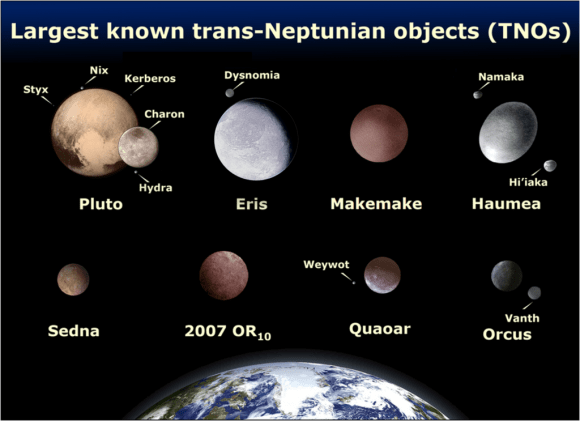
It was later learned that the object had been previously observed by the Samual Oschin telescope as well as the Jet Propulsion Laboratory’s Near Earth Asteroid Tracking (NEAT) consortium. Comparisons with these previous observations have since allowed for a more precise calculation of Sedna’s orbit and orbital arc.
According to Mike Brown’s website, the planet was named Sedna after the Inuit Goddess of the sea. According to legend, Sedna was once mortal but became immortal after drowning in the Arctic Ocean, where she now resides and protects all the creatures of the sea. This name seemed appropriate to Brown and his team because Sedna is currently the farthest (and hence coldest) object from the Sun.
The team made the name public before the object had been officially numbered; and while this represented a breach in IAU protocol, no objections were raised. In 2004, the IAU’s Committee on Small Body Nomenclature formally accepted the name.
Classification:
Astronomers remain somewhat divided when it comes to Sedna’s proper classification. On the one hand, its discovery resurrected the question of which astronomical objects should be considered planets and which ones could not. Under the IAU’s definition of a planet, which was adopted on August 24th, 2006 (in response to the discovery of Eris), a planet needs to have cleared its orbit. Hence, Sedna does not qualify.
However, to be a dwarf planet, a celestial body must be in hydrostatic equilibrium – meaning that it is symmetrically rounded into a spheroid or ellipsoid shape. With a surface albedo of 0.32 ± 0.06 – and an estimated diameter of between 915 and 1800 km (compared to Pluto’s 1186 km) – Sedna is bright enough, and also large enough, to be spheroid in shape.
Therefore, Sedna is believed by many astronomers to be a dwarf planet, and is often referred to confidently as such. One reason why astronomers are reluctant to definitively place it in that category is because it is so far away that it is difficult to observe.
Size, Mass and Orbit:
In 2004, Mike Brown and his team placed an upper limit of 1,800 km on its diameter, but by 2007 this was revised downward to less than 1,600 km after observations were made by the Spitzer Space Telescope. In 2012, measurements from the Herschel Space Observatory suggested that Sedna’s diameter was between 915 and 1075 km, which would make it smaller than Pluto’s moon Charon.
Because Sedna has no known moons, determining its mass is currently impossible without sending a space probe. Nevertheless, many astronomers think that Sedna is the fifth largest trans-Neptunian object (TNO) and dwarf planet – after Eris, Pluto, Makemake, and Haumea, respectively.
Sedna has a highly elliptical orbit around the Sun, which means it ranges in distance from 76 astronomical units (AU) at perihelion (114 billion km/71 billion mi) to 936 AU (140 billion km/87 billion mi) at aphelion.
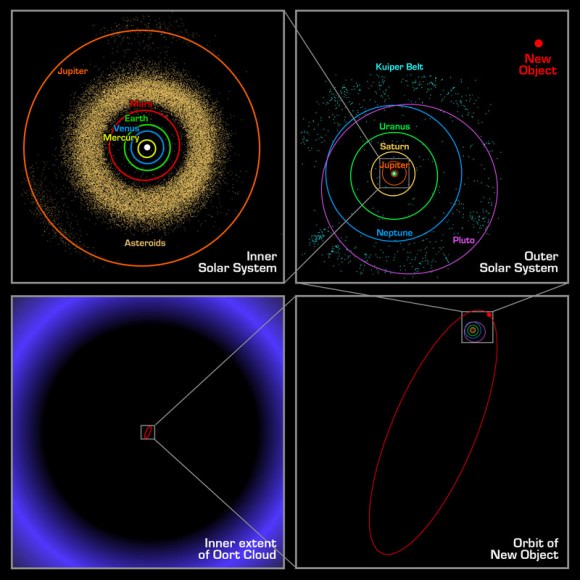
Estimations on how long it takes Sedna to orbit the Sun vary, although it is known to be more than 10,000 years. Some astronomers calculate the orbital period could be as long as 12,000 years. Although astronomers believed at first that Sedna had a satellite, they have not been able to prove it.
Composition:
At the time of its discovery, Sedna was the intrinsically brightest object found in the Solar System since Pluto in 1930. In terms of color, Sedna appears to be almost as red as Mars, which some astronomers believe is caused by hydrocarbon or tholin. Its surface is also rather homogeneous in terms of color and spectrum, which may the result of Sedna’s distance from the Sun.
Unlike planets in the Inner Solar System, Sedna experiences very few surface impacts from meteors or stray objects. As a result, it does not have as many exposed bright patches of fresh icy material. Sedna, and the entire Oort Cloud, is freezing at temperatures below 33 Kelvin (-240.2°C).
Models have been constructed of Sedna that place an upper limit of 60% for methane ice and 70% for water ice. This is consistent with the existence of tholins on it’s surface, since they are produced by the irradiation of methane. Meanwhile, M. Antonietta Barucci and colleagues compared Sedna’s spectrum to that of Triton and came up with a model that included 24% Triton-type tholins, 7% amorphous carbon, 10% nitrogen, 26% methanol and 33% methane.
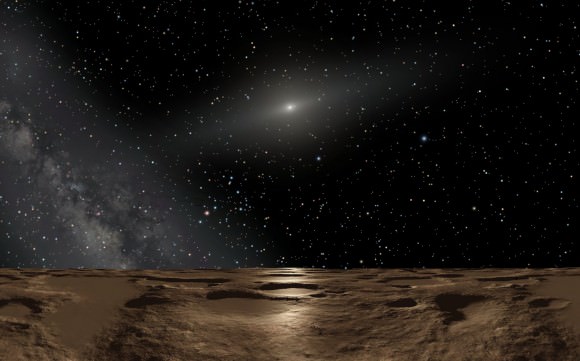
The presence of nitrogen on the surface suggests the possibility that, at least for a short time, Sedna may have a tenuous atmosphere. During a 200-year period near perihelion, the maximum temperature on Sedna would likely exceed 35.6 K (-237.6 °C), which would be just warm enough for some of the nitrogen ice to sublimate. Models of internal heating via radioactive decay suggest that, like many bodies in the Outer Solar System, Sedna might be capable of supporting a subsurface ocean of liquid water.
Origin:
When he and his colleagues first observed Sedna, they claimed that it was part of the Oort Cloud – the hypothetical cloud of comets believed to exist a light-year’s distance from the Sun. This was based on the fact that Sedna’s perihelion (76 AUs) made it too distant to be scattered by the gravitational influence of Neptune.
Because it was also closer to the Sun than was expected from on Oort cloud object, and has an inclination in line with the planets and Kuiper Belt, they described it as being an “inner Oort Cloud object”. Brown and his colleagues have proposed that Sedna’s orbit is best explained by the Sun having formed in an open cluster of several stars that gradually disassociated over time.
In this scenario, Sedna was lifted into its current orbit by a star that was part of this cluster rather than it having been formed in its current location. This hypothesis has also been confirmed by computer simulations that suggest that multiple close passes by young stars in such a cluster would pull many objects into Sedna-like orbits.
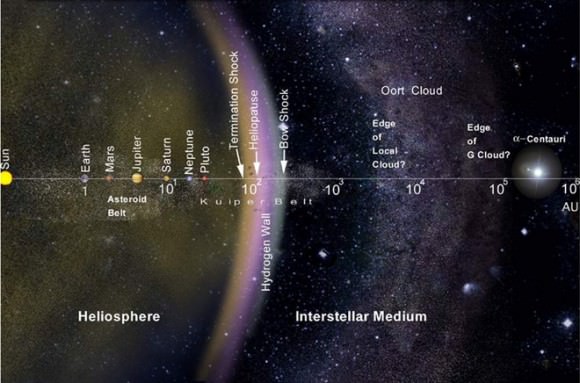
On the other hand, if Sedna formed in its current location, then it would mean that the Sun’s original protoplanetary disc would have extended farther than previously expected – approximately 75 AUs into space. Also, Sedna’s initial orbit would have been approximately circular, otherwise its formation by the accretion of smaller bodies into a whole would not have been possible.
Therefore, it must have been tugged into its current eccentric orbit by a gravitational interaction with another body – which could have been another planet in the Kuiper Belt, a passing star, or one of the young stars embedded with the Sun in the stellar cluster in which it formed.
Another possibility is the Sedna’s orbit is the result of influence by a large binary companion thousands of AU distant from our Sun. One such hypothetical companion is Nemesis, a dim companion to the Sun. However, to date no direct evidence of Nemesis has been found, and many lines of evidence have thrown its existence into doubt.
More recently, it has also been suggested that Sedna did not originate in the Solar System, but was captured by the Sun from a passing extrasolar planetary system.
Astronomers believe that they will find more objects in the Oort Cloud in years to come, especially as ground-based and space telescopes become more advanced and sensitive. Most likely, we will also see Sedna officially christened a “dwarf planet” by the IAU. As with other astronomical bodies that have been designated as such, we can expect some controversy to follow!
Universe Today has many interesting articles on Sedna, including Sedna probably doesn’t have a moon and Dwarf Planets.
For more information, check out the story of Sedna and Sedna.
Astronomy Cast has an episode on Pluto and the icy outer Solar System, and The Oort Cloud.
Sources:

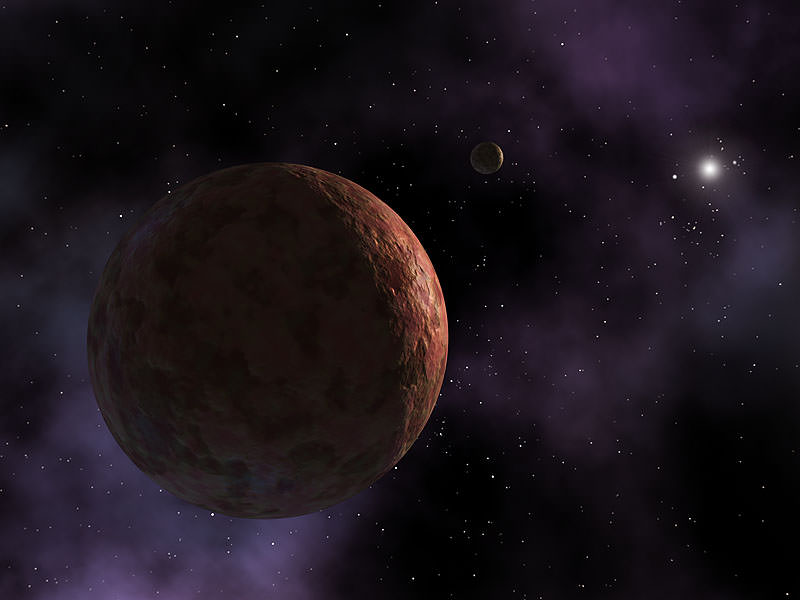
Let’s just ignore IAU’s failed planet definition and simply keep on calling planets planets. If it is massive enough to be round, but not massive enough to have or ever have had any fusion process going on in its core, then it is a planet. Everyone knows it when they see it. Then there are subcategories like dwarf planets and moon planets and vagabond planets and gas planets and terrestrial planets and more depending on the context of sizes and orbits and whatnot. I do believe that people can handle numbers larger than eight, and that it doesn’t matter that everyone cannot name even the 8 IAU planets. They still know what a planet is when they see one, regardless of its name or stupid classification, because we all grew up on a planet. (Can there exist more than 8 countries on Earth, or elements in the periodic table??) Small bodies registers can keep on doing their numbering as they find practical anyway, Pluto is a planet which is a small body. Its so simple and obvious.
Please don’t call a potential distant Solar companion star or giant planet “Nemesis”. That only provokes even more. It isn’t even a formal IAU nomenclature, is it? So why do you pick and choose names here randomly? It does get you more “clicks”, and that might be what you are paid for by writing here, but you would have gotten my click anyway.
Partly good article anyway, I just point out what old worn pieces of it that won’t work.
You are the pseudoFALAist. 😀
Many planetary scientists have long ignored the controversial IAU definition. Alan Stern is the person who first coined the term “dwarf planet,” and his intention was to designate a new subclass of planets, not to designate non-planets. There is no reason the IAU definition should have any sort of privileged status, especially over a definition coined by someone who successfully sent a spacecraft to a Kuiper Belt planet.
The possibility of an object as far from the Sun as Sedna having a subsurface ocean and possibly active geology is fascinating. Ceres, Pluto, and Charon may also harbor subsurface oceans. These dwarf planets may be the solar system’s secret water worlds.
http://i2.photobucket.com/albums/y33/HeadAroundU/the%20dwarf%20and%20the%20king%20of%20dwarfs.jpg
http://i2.photobucket.com/albums/y33/HeadAroundU/we%20love%20mike%20brown.jpg
I know there have been records on Earth about noting past supernova… see https://en.wikipedia.org/wiki/Near-Earth_supernova#Past_events
It would be interesting to see if going in and out of the heliosphere affected Sedna. Exploring the moons that go in and out of their planets magnetosphere might yield more clues how to look for these objects that cross in and out of being exposed to differing environments.
thanks Matt. I love reading about Sedna.
NASA stage coach wagon took nine years to arrive at Pluto. That is too much. In first year college calculus if you could not solve a small problem in cartesian coordinate. You have to do cylindrical or spherical transformation. Said my son who is drop out of highschool and become a plumber. I wonder how long the NASA stage coach is going to take before arriving to sedna